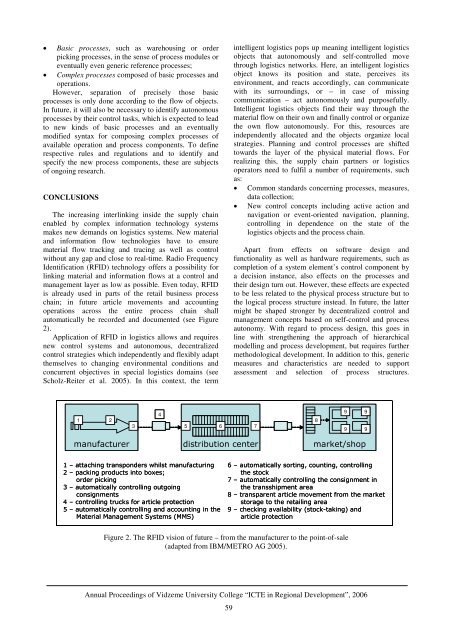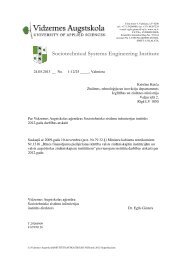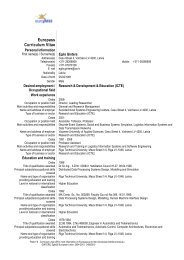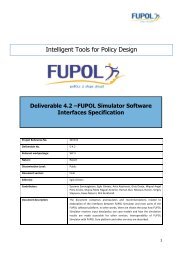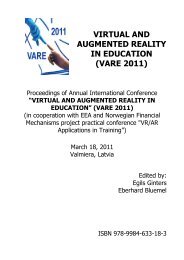coexistence of both control and management approaches.The challenge to research then consists <strong>in</strong> identify<strong>in</strong>gwhich level of self-control is sensible and efficient forwhich logistics scenario.Furthermore, the question is to be answered if processautonomy reduces process complexity <strong>in</strong> the design ofcontrol and management layers at all and to what extent.For this, measures for characteriz<strong>in</strong>g and evaluat<strong>in</strong>gprocess complexity are to be def<strong>in</strong>ed first. Because ofexist<strong>in</strong>g analogies those characteristics could eventuallybe derived from the level of cooperation κ and the levelof separation γ as known from the field of structur<strong>in</strong>gmanufactur<strong>in</strong>g systems (see Schmigalla 1966):• The level of physical cooperation κ P expresses theaverage number of processes a certa<strong>in</strong> process isphysically l<strong>in</strong>ked with, i.e. due to the material flow;• The level of logical cooperation κ L expresses theaverage number of processes a certa<strong>in</strong> process islogically l<strong>in</strong>ked with, i.e. due to the <strong>in</strong><strong>format</strong>ion flowor because of the control and management concept;• The level of separation <strong>in</strong> the way of runn<strong>in</strong>g theprocess γ PF describes the average proportionbetween the number of decision processes carriedout <strong>in</strong> a specific part of process control andmanagement and the total number of requireddecision processes. The smaller γ PF is, the lower theconcentration of decision-mak<strong>in</strong>g power is and adistributed way of runn<strong>in</strong>g the process can beassumed; purposefulness of process autonomy canbe given a boost.The bigger the level of cooperation and the smaller thelevel of separation is, the more complex the process is.To assess the “ability of autonomy” with a process it isnecessary to clarify how many decisions this processmakes without external support (by a higher control ormanagement layer) and which level of cooperation orseparation allows which level of autonomy. From thesethoughts, recommendations for purposeful decisionsabout autonomy and for assess<strong>in</strong>g the result<strong>in</strong>g processcomplexity could eventually be derived. Pre-conditionsare measures and characteristics enabl<strong>in</strong>g to describe andevaluate the logistics process structure as well as to ga<strong>in</strong>respective design guidel<strong>in</strong>es. Until now they are not to befound <strong>in</strong> logistics process design, whereas a large numberof performance-oriented technical or economiccharacteristics typically do exist to assess a logisticsprocess or even better the performance of a logisticssystem.The measures discussed earlier seem to beappropriate to close this gap; to correctly <strong>in</strong>terpret themthe <strong>in</strong>fluence of different process structures and conceptsfor runn<strong>in</strong>g the process is to be <strong>in</strong>vestigatedsystematically.Process design for <strong>in</strong>telligent objectsLogistics process design aims at strategically creat<strong>in</strong>ga logistics process <strong>in</strong> its entirety of material and<strong>in</strong><strong>format</strong>ion flow operations. This <strong>in</strong>cludes both processconfigurations, i.e. def<strong>in</strong><strong>in</strong>g the process structure, andprocess dimension<strong>in</strong>g, i.e. def<strong>in</strong><strong>in</strong>g process parameterssuch as decision strategies; it is the basis for a conceptualdesign of the control algorithm. Process design for<strong>in</strong>telligent logistics objects differs from traditionallogistics process design <strong>in</strong> that decisions about selfcontroland autonomy are to be made as well. This is oflast<strong>in</strong>g <strong>in</strong>fluence especially on the lower managementand control layers:• Shift<strong>in</strong>g activities for runn<strong>in</strong>g the process towardslower management and control layers causesorganizational changes to process structure andprocess operation.• At <strong>in</strong>tegration level work flows and process plansare to be adapted to <strong>in</strong>telligent logistics objects andshould result <strong>in</strong> a shortened process.To solve design problems for <strong>in</strong>telligent logisticsprocesses it is to be <strong>in</strong>vestigated which concepts,methods and characteristics from other doma<strong>in</strong>s, such asmanufactur<strong>in</strong>g structure plann<strong>in</strong>g (see Schmigalla 1966)or logistics system design, can be applied to processdesign. Amongst others, they ought to provide a basis fordecid<strong>in</strong>g about a suitable process structure (self-controlor heteronomous control, autonomous processes,coord<strong>in</strong>ation of autonomous processes and <strong>in</strong>telligentobjects, process operation beyond object or systemboundaries), too. Especially aga<strong>in</strong>st the background ofself-control and process autonomy, there are manyparallels to design concepts, such as de-coupl<strong>in</strong>g,modularization, or fragmentation, and design methods,like e.g. logistics simulation.Component-based simulation packages, for example,are already based upon the concept of <strong>in</strong>telligent objectsor <strong>in</strong>telligent systems that <strong>in</strong>dependently make localcontrol decisions (e. g. related to an object type oraccord<strong>in</strong>g to the state of the current model componentand the previous or follow<strong>in</strong>g one respectively). Theimplemented separation of local and global decisionprocesses is predef<strong>in</strong>ed by the tool (and method) andallowed def<strong>in</strong><strong>in</strong>g standard strategies for selected controlneeds.Until now, the approach of a component-basedprocess design us<strong>in</strong>g hierarchical sub-structures (seeNeumann 2005 and Bernhard et al. 2005) is ma<strong>in</strong>lyoriented towards requirements of the physical processstructure. Indeed, the concept dist<strong>in</strong>guishes between• Elementary or comb<strong>in</strong>ed material flow and<strong>in</strong><strong>format</strong>ion flow operations, like e. g. keep<strong>in</strong>g,mov<strong>in</strong>g or sort<strong>in</strong>g, that realize purposefultrans<strong>format</strong>ion of one s<strong>in</strong>gle object characteristic(that is sort, quantity, location or time);Annual <strong>Proceed<strong>in</strong>gs</strong> of Vidzeme University College “ICTE <strong>in</strong> Regional Development”, 200658
• Basic processes, such as warehous<strong>in</strong>g or orderpick<strong>in</strong>g processes, <strong>in</strong> the sense of process modules oreventually even generic reference processes;• Complex processes composed of basic processes andoperations.However, separation of precisely those basicprocesses is only done accord<strong>in</strong>g to the flow of objects.In future, it will also be necessary to identify autonomousprocesses by their control tasks, which is expected to leadto new k<strong>in</strong>ds of basic processes and an eventuallymodified syntax for compos<strong>in</strong>g complex processes ofavailable operation and process components. To def<strong>in</strong>erespective rules and regulations and to identify andspecify the new process components, these are subjectsof ongo<strong>in</strong>g research.CONCLUSIONSThe <strong>in</strong>creas<strong>in</strong>g <strong>in</strong>terl<strong>in</strong>k<strong>in</strong>g <strong>in</strong>side the supply cha<strong>in</strong>enabled by complex <strong>in</strong><strong>format</strong>ion technology systemsmakes new demands on logistics systems. New materialand <strong>in</strong><strong>format</strong>ion flow technologies have to ensurematerial flow track<strong>in</strong>g and trac<strong>in</strong>g as well as controlwithout any gap and close to real-time. Radio FrequencyIdentification (RFID) technology offers a possibility forl<strong>in</strong>k<strong>in</strong>g material and <strong>in</strong><strong>format</strong>ion flows at a control andmanagement layer as low as possible. Even today, RFIDis already used <strong>in</strong> parts of the retail bus<strong>in</strong>ess processcha<strong>in</strong>; <strong>in</strong> future article movements and account<strong>in</strong>goperations across the entire process cha<strong>in</strong> shallautomatically be recorded and documented (see Figure2).Application of RFID <strong>in</strong> logistics allows and requiresnew control systems and autonomous, decentralizedcontrol strategies which <strong>in</strong>dependently and flexibly adaptthemselves to chang<strong>in</strong>g environmental conditions andconcurrent objectives <strong>in</strong> special logistics doma<strong>in</strong>s (seeScholz-Reiter et al. 2005). In this context, the term<strong>in</strong>telligent logistics pops up mean<strong>in</strong>g <strong>in</strong>telligent logisticsobjects that autonomously and self-controlled movethrough logistics networks. Here, an <strong>in</strong>telligent logisticsobject knows its position and state, perceives itsenvironment, and reacts accord<strong>in</strong>gly, can communicatewith its surround<strong>in</strong>gs, or – <strong>in</strong> case of miss<strong>in</strong>gcommunication – act autonomously and purposefully.Intelligent logistics objects f<strong>in</strong>d their way through thematerial flow on their own and f<strong>in</strong>ally control or organizethe own flow autonomously. For this, resources are<strong>in</strong>dependently allocated and the objects organize localstrategies. Plann<strong>in</strong>g and control processes are shiftedtowards the layer of the physical material flows. Forrealiz<strong>in</strong>g this, the supply cha<strong>in</strong> partners or logisticsoperators need to fulfil a number of requirements, suchas:• Common standards concern<strong>in</strong>g processes, measures,data collection;• New control concepts <strong>in</strong>clud<strong>in</strong>g active action andnavigation or event-oriented navigation, plann<strong>in</strong>g,controll<strong>in</strong>g <strong>in</strong> dependence on the state of thelogistics objects and the process cha<strong>in</strong>.Apart from effects on software design andfunctionality as well as hardware requirements, such ascompletion of a system element’s control component bya decision <strong>in</strong>stance, also effects on the processes andtheir design turn out. However, these effects are expectedto be less related to the physical process structure but tothe logical process structure <strong>in</strong>stead. In future, the lattermight be shaped stronger by decentralized control andmanagement concepts based on self-control and processautonomy. With regard to process design, this goes <strong>in</strong>l<strong>in</strong>e with strengthen<strong>in</strong>g the approach of hierarchicalmodell<strong>in</strong>g and process development, but requires furthermethodological development. In addition to this, genericmeasures and characteristics are needed to supportassessment and selection of process structures.1 23456789999manufacturerdistribution centermarket/shop1 – attach<strong>in</strong>g transponders whilst manufactur<strong>in</strong>g2 – pack<strong>in</strong>g products <strong>in</strong>to boxes;order pick<strong>in</strong>g3 – automatically controll<strong>in</strong>g outgo<strong>in</strong>gconsignments4 – controll<strong>in</strong>g trucks for article protection5 – automatically controll<strong>in</strong>g and account<strong>in</strong>g <strong>in</strong> theMaterial Management <strong>Systems</strong> (MMS)6 – automatically sort<strong>in</strong>g, count<strong>in</strong>g, controll<strong>in</strong>gthe stock7 – automatically controll<strong>in</strong>g the consignment <strong>in</strong>the transshipment area8 – transparent article movement from the marketstorage to the retail<strong>in</strong>g area9 – check<strong>in</strong>g availability (stock-tak<strong>in</strong>g) andarticle protectionFigure 2. The RFID vision of future – from the manufacturer to the po<strong>in</strong>t-of-sale(adapted from IBM/METRO AG 2005).Annual <strong>Proceed<strong>in</strong>gs</strong> of Vidzeme University College “ICTE <strong>in</strong> Regional Development”, 200659
- Page 1 and 2:
ISBN 9984-633-03-9Annual Proceeding
- Page 3 and 4:
“Development of Creative Human -
- Page 5 and 6:
TABLE OF CONTENTSINTELLIGENT SYSTEM
- Page 7 and 8:
INTELLIGENT SYSTEM FOR LEARNERS’
- Page 9 and 10:
LEARNER 1GROUP OF HUMAN AGENTSLEARN
- Page 11 and 12:
QuantityQuantityFigure 6. Distribut
- Page 13 and 14: LEARNERStructure of theconcept mapL
- Page 15 and 16: WEB-BASED INTELLIGENT TUTORING SYST
- Page 17 and 18: materials to be presented and which
- Page 19 and 20: INFORMATION TECHNOLOGIES AND E-LEAR
- Page 21 and 22: correspondence with the course aim
- Page 23 and 24: projects and through IT. Hence, it
- Page 25 and 26: APPLICATION OF MODELING METHODS IN
- Page 27 and 28: can support configuration managemen
- Page 29 and 30: The EKD is one of the Enterprise mo
- Page 31 and 32: CHANGES TO TRAINING AND PERSPECTIVE
- Page 33 and 34: or an end, yet none of these attitu
- Page 35 and 36: make decisions. It cannot be volunt
- Page 37 and 38: logs), data and video conferencing
- Page 39 and 40: Ability to follow user’s multi-ta
- Page 41 and 42: CONCLUSIONSEDUSA method gives us a
- Page 43 and 44: in successful SD. Given this situat
- Page 45 and 46: SPATIAL INFORMATIONFor the visualis
- Page 47 and 48: MOBILE TECHNOLOGIES USE IN SERVICES
- Page 49 and 50: learning environment (Learning Mana
- Page 51 and 52: ago only some curricula on Logistic
- Page 53 and 54: The Web-based version can be access
- Page 55 and 56: Web-portal, which incorporates diff
- Page 57 and 58: DO INTELLIGENT OBJECTS AUTOMATICALL
- Page 59 and 60: Table 1. Examples for introducing R
- Page 61 and 62: workable influencing of the process
- Page 63: are handed over to the objects and
- Page 67 and 68: THE ECR E-COACH: A VIRTUAL COACHING
- Page 69 and 70: participating in the workshops and
- Page 71 and 72: • Assessment modules enable indiv
- Page 73 and 74: with pictures and illustrated graph
- Page 75 and 76: ECR Question Banknumber category su
- Page 77 and 78: educational programme that follows
- Page 79 and 80: DEVELOPMENT OF WEB BASED GRAVITY MO
- Page 81 and 82: These results of a model require a
- Page 83 and 84: CONCLUSIONSThe main goal of work ha
- Page 85 and 86: dimension and included within any o
- Page 87 and 88: • Resources sharing by providing
- Page 89 and 90: Pursuant to the guidelines of elect
- Page 91 and 92: tariffs of regulated services have
- Page 93 and 94: INFORMATION TECHNOLOGY FOR MOTIVATI
- Page 95 and 96: difficult to predict when and for w
- Page 97 and 98: Listeners' workon the WebListenersS
- Page 99 and 100: PERSPECTIVES OF WEB PAGE AND E-MAIL
- Page 101 and 102: INCREASE IN THE NUMBER OF INTERNETU
- Page 103 and 104: tourism accommodations (home pages
- Page 105 and 106: interactive relationships with clie
- Page 107 and 108: • The data obtained by the resear
- Page 109 and 110: Central Statistical Bureau of Latvi
- Page 111 and 112: departures for 1995 are taken from
- Page 113 and 114: 120100maximumworldminimum806040200-
- Page 115 and 116:
140120maximumworldminimum1008060402
- Page 117 and 118:
would be a promising extension. Cur
- Page 119 and 120:
AN OVERVIEW OF THE AGENT − BASED
- Page 121 and 122:
Suitability for social system simul
- Page 123 and 124:
6. MASONDescription:MASON is a fast
- Page 125 and 126:
Suitability for social system simul
- Page 127 and 128:
could be bad particularly when over
- Page 129 and 130:
(for 10 repeat &| CCar[]->runfor);P
- Page 131 and 132:
• Streaming audio• Collaboratio
- Page 133 and 134:
NECESSITY OF NEW LAYERED APPROACH T
- Page 135 and 136:
Up to now, there has only been limi
- Page 137 and 138:
aaaaa6= −aa2,1 = − a0,3226= −
- Page 139 and 140:
∂ u∂x∂ u∂y2 2+ b = 02 2wher
- Page 141 and 142:
a6,3= −2030a4,5−130a4,3- - - -
- Page 143 and 144:
0,10,20,30,4( )Mag x y y Ge wx2, =
- Page 145 and 146:
Example 1. To understand better the
- Page 147 and 148:
Therefore, further the following co
- Page 149 and 150:
SOLUTION OF THE THREE-DIMENSIONALEQ
- Page 151 and 152:
Mag1, m , m , m1 2 3= mm1 m2m32 2 2
- Page 153 and 154:
MagMag0, m , m , m1 2 31, m , m , m
- Page 155:
CONCLUSIONSThe basic content of thi


